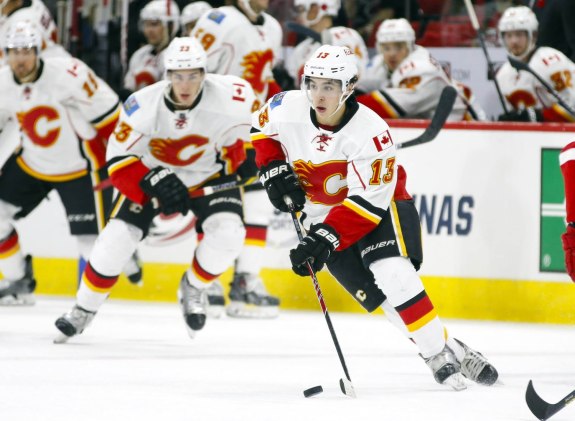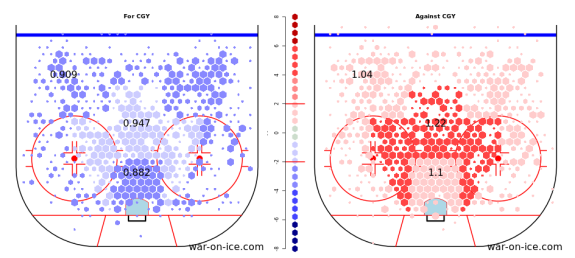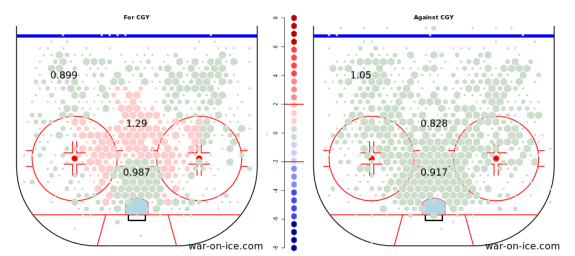The Calgary Flames have been a favorite topic for the analytics community this season. Or, maybe more accurately, the Calgary Flames’ regression prospects have been a favorite battlefield between the analytics community and Flames fans this season.
The Flames have outperformed even the most generous of projections for their season through the first two months. Much like we saw with the Colorado Avalanche last year, the Flames have been the benefactor of some fantastic goaltending and an above average shooting percentage. (The details are different between the two teams, but the framework is the same.) In fact, their shooting percentage from the start of the season through December 4th was second best in the NHL at 5-on-5 at 9.6%.

Through that same stretch their goaltending was just above the middle of the pack at .924. That’s in part due to some strong play from Jonas Hiller, who posted a 92.84 adjusted save percentage over that stretch.
But, with the Flames on an eight-game losing streak and three points out of a wild card spot, has the much-discussed regression set in or is something else going on?
How to Regress
It probably won’t surprise you to discover that the team’s 102 PDO from the start of the season through December 4, third highest in the league, is significantly lower over the eight-game losing streak. That’s both telling and a little like saying that the team has been outscored over the eight-game losing streak. It’s a little obvious.
Over the losing streak the Flames a 96.8 PDO, the result of a fall from a 9.6% shooting percentage to a 5.5%. The goaltending has also trailed off, though not bottomed-out, with a .913 5-on-5 Sv% during the streak.
| Games | CF% 5-on-5 | OSh% | OSv% | PDO | |
|---|---|---|---|---|---|
| through 12/04/14 | 27 | 43.50% | 9.60% | 92.40% | 102 |
| 12/05/14-12/20/14 | 8 | 49.70% | 5.50% | 91.30% | 96.8 |
| Overall | 35 | 44.90% | 8.60% | 92.20% | 100.7 |
Is that regression? A little bit. They’ve been below league average in that span in both categories, though it’s such a small sample that it’s maybe not accurate to say that they “have regressed,” but they appear to be regressing toward the team we thought they’d be once the noise was reduced a bit.
They’ve trending back, yes. But even with this slump, they still seem to have some higher-than-expected numbers. The team’s 5-on-5 shooting percentage sits at 8.6%, tied for sixth in the NHL. The team save percentage is .922, which is just behind the middle of the pack.
That adds up to a PDO of 100.7, ninth in the league. That’s not an unmanageable PDO, but it does seem high for a team who has a 44.9% Corsi For, putting them ahead of only Buffalo and Colorado (by.1%) in terms of possession.
Possession isn’t 100% of the game, but it does give an idea of what’s likely to happen and the Flames maintaining their point percentage of the early season looks incredibly unlikely. On the upside, their possession numbers have improved slightly over the losing streak, but that’s such a small sample size it’s hard to say that it really indicates a trend. Flames fans can also take refuge, if they’d like, in Colorado’s performance last year. Regression doesn’t necessarily have defined start and end points. Colorado won the Central despite poor possession and a very high shooting percentage. While I’d contend it’s unlikely that the Flames buck trends and do that well with poor possession and a high shooting percentage, it’s not impossible.
It’s the Shot Quality, Stupid
This is an alarming situation for the Flames because, despite speculative assertions, the Flames aren’t producing more high quality scoring opportunities than other teams and they aren’t suppressing chances by the opposition particularly well. Travis Yost’s recent article on multi-shot shifts throws this into even clearer light as you see the Flames allowing far more multi-shot shifts than they’re getting themselves.
The below hextally chart shows the Flames taking fewer than the league average number of shots from every region of the offensive zone (left side), especially in that high shooting percentage area right in front of the net. The other half of the chart shows the Flames giving up more than a league average number of shots in every section of the defensive zone. 1.1 in the high risk area and 1.22 in the medium risk zone are particularly troubling numbers for the team.
A hextally chart below outlines the shooting percentage for and against in those zones. The notable numbers here are the Flames having a really high shooting percentage from the slot and having a surprisingly low shooting percentage against in the two highest risk zones. These are both trends that are unlikely to continue.
If the highs of the early season can be attributed to variance, then the Flames should expect to see be a team who performs a little closer to what we’ve seen over the last couple weeks. Will they keep losing like this? Almost certainly not. The Flames are probably better than they were given credit for in the preseason, but they aren’t the team we saw early in the season either. There’s a lot going right with this team and the rebuild would seem to be going well, but despite a hot start, the Flames have not discovered the secret to fast forward the rebuilding process.

